Study on Hydraulic Characteristic of Unsteady Flow at Huangchigou Water Distribution Hub by Observing Instantaneous Water Level Based on Single-Camera and Fixed-Scale Compensation Method
Abstract
The Huangchigou Water Distribution Hub is the core water distribution structure in the Hanjiang-to-Weihe Valley Water Diversion Project. It plays a decisive role in ensuring the safety of downstream water transport, allocating water reasonably and reducing the waste of abandoned water. The study on its unsteady-flow hydraulic characteristics is of key significance in the formulation for the opening and closing rules of the hub gates. The shape of the instantaneous water surface profile is an important factor for the hydraulic characteristics of the unsteady flow in the hub. The effect of the traditional instantaneous water level measurement method is not ideal. A single-camera and fixed-scale compensation method is proposed for an instantaneous water level observation. The proposed method meets the requirement of measurement accuracy and reduces the observation cost of the model test. The unsteady-flow test of the hydraulic model in the Southern Main Tunnel of the Huangchigou Water Distribution Hub was carried out under two operating conditions when the model flow is 0.0246 m3/s. Precise data such as wave front propagation velocity and hydraulic oscillation recovery time of unsteady flows in the Southern Main Tunnel was obtained. It has an important reference value for the research and design of water transfer dispatching and gate-opening and gate-closing rules for the Huangchigou Water Distribution Hub.
1. Engineering Background
Unsteady flow is a kind of hydraulic transient process in the process of water conveyance. The great changes of hydraulic elements take place in a short time. To ensure safe and effective water diversion, there is vital significance to formulate reasonable gate-opening and gate-closing rules by analyzing the instantaneous water level variation features and time variation law of hydraulic oscillation.
The Hanjiang-to-Weihe Valley Water Diversion Project, from the Yangtze River to the Yellow River drainage, is a cross-basin water transfer project in Shaanxi Province, China. It consists of two major parts: one is the water transfer project (the first stage) and another is the water transmission and distribution project (the second stage).
The Huangchigou Water Distribution Hub, as the connection center of the water transfer project and the water transmission and distribution project, is the core water distribution structure. It has a decisive role for the safe and rapid water distribution in the whole project. Due to the limited volume of the pool (about 20,800 m3), two-inlet and two-outlet gates, large flow fluctuation (12.5~70 m3/s), and poor control ability, it is necessary to find an appropriate control operation scheme. The research results can put forward reasonable suggestions for the design of the hub layout and the size of key structure parts.
Two main water delivery routes, the Southern Main Route and the Northern Main Route, are arranged according to the linear distribution characteristics of water-receiving objects. Among them, the Southern Main Route is an open channel tunnel. The section of the Southern Main Tunnel model has a horseshoe shape with a size 0.398 m × 0.239 m. In the process of unsteady-flow water delivery, the instantaneous water level shape determines the open channel flow state in the tunnel. How to measure the instantaneous water level in the model tunnel becomes a key issue.
2. Research Status on Water Level Measurement of Unsteady Flow and Water Transfer Control in Open Channel
At present, the main methods for measuring the water lever include the tracking water level meter method, ultrasonic method, optical method, and so on. Majdalani et al. [1] proposed a method combining a near-infrared sensor and float for the water level measurement of unsteady flow in the laboratory. The measuring range is 2 cm, and the accuracy is up to 1 mm. Shu et al. [2] proposed an underwater high-precision ultrasonic water level measurement method. The experimental results demonstrate that the error is less than 0.1 mm in the 400 mm range. The proposed method can be widely used in high-precision water level measurements in hydraulic physical model experiments.
Hu et al. [3], Liu et al. [4], and Song and Graf [5] carried out indoor experiments on the unsteady-flow wave propagation characteristics, sediment transport capacity, flow velocity, and vortex in channel models. But they all used the ultrasonic water level meter to measure the water level. The drawbacks of this approach are both a small number of measuring points and higher cost.
The optical water level measurement method can measure the water level by using a camera to capture the scale image to obtain the quantitative water level information. This method has the advantages of noncontact measurement, no temperature drift, traceable results, and low system cost. Guo et al. [6] developed a water level measurement method based on image processing and sparse representation. Their experimental results indicated that the method has a strong robustness to light variation, local disability, foreign matter occlusion, and so forth. Further, the maximum error of the method is less than 0.9 cm, which is significantly smaller than other image-processing methods based on water level recognition methods such as the frame difference method, image segmentation method, and Hough transform. Zhang et al. [7] developed an all-weather, real-time, and automatic flow measurement system using a single near infrared- (NIR-) imaging video camera to resolve difficulties of poor visibility, image distortions, and ambient noises in in situ water level measurements with standard bicolor staff gauges. Zhong [8] proposed a method using a camera to capture a video containing a water gauge and intercepted the water level image from the video in real time. After grayscale conversion, median filtering, and edge detection, the image containing the scale calibration is obtained. According to the number of scale readings identified, the water level result is calculated in the subsequent processing. The method for calculating the water level results, compared with the manual direct reading of the water gauge, has an accuracy of 0.6 cm. This method is suitable for the remote measurement of the water level in lakes, reservoirs, and culverts. Ren et al. [9] presented a new algorithm of automatic water lever detection based on image processing. By integrating technologies on shape correction, edge detection, contour tracing and analysis, morphology, projection analysis, and so on, the method has achieved high accuracy and practical application. A similar approach was proposed by Zhou and Zhong [10].
Aiming at the water level operation control mode in large-scale water transmission open channels, Cui et al. [11] studied the constant water level operation control mode in front of the gates on a large-scale water transmission open channel in the background of the Trunk Canal at the middle route of the South-to-North Water Diversion Project in China. Fang et al. [12] studied the water level variation law of the flow changes at the water outlet in the main canal at the middle water transfer channel of the South-to-North Water Diversion Project. Li et al. [13] took a canal section in the middle water transfer channel of the South-to-North Water Diversion Project as a typical example and studied the hydraulic characteristics on the open channel water delivery system under the control of the control gate. Litrico and Fromion [14], Bautista and Clemmens [15], and Clemmens et al. [16] used the method of feedforward control and storage compensation to simulate the operation scheduling of irrigation channels. The above studies have adopted the method of numerical model simulation, while the multipoint water level measurement of the unsteady flow in the open channel model has an important reference value to test the rationality and objectivity of the unsteady-flow water level simulation results.
The research results of the above literatures show that the study on unsteady flow in the open channel is aimed at the safe transportation and dispatching of the hydraulic system. The laboratory experiment of the open channel flow is aimed at studying the change law of hydraulic elements. In the large-scale hydraulic model test, there are few observation results on the instantaneous water level and the instantaneous water surface profile.
A large-scale (1 : 15) hydraulic physical test model of the Huangchigou Water Distribution Hub was established for the hydraulic test of unsteady flow. During the unsteady-flow test, an open channel unsteady flow is formed in the Southern Main Tunnel, but it is difficult to observe the instantaneous water level of multiple points synchronously. In this paper, a single-camera and fixed-scale compensation method was proposed to measure the instantaneous water level of the Water Distribution Pool and the Southern Main Tunnel, and two operating conditions were considered. The characteristics and law of the water level changes in the pool and tunnel were analyzed when the inlet gate of the Southern Main Tunnel is rapidly opened and closed, so as to provide the basis for the design and operation rules of the Water Distribution Hub.
3. The Principle and Procedure of Measuring the Instantaneous Water Level Based on the Single-Camera and Fixed-Scale Compensation Method
3.1. Principle of Measurement
The single camera is too far from the measuring point, resulting in an indistinct reading of each steel ruler in the image (Figure 1). To overcome this problem, an instantaneous water level observation method for unsteady flow based on single-camera and fixed-scale compensation is proposed because of the clearly visible water surface profile in the model at a certain distance.
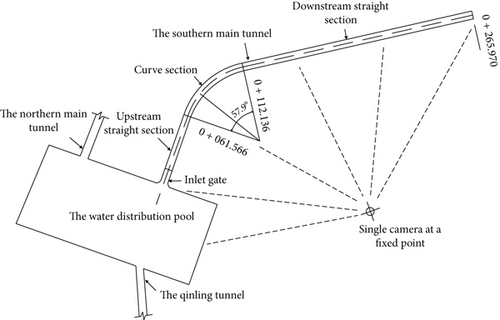
3.2. Installation of Fixed Scale and Camera Equipment
The specifications of the fixed scales are unified as a red polymethyl methacrylate plate with a height of 60.0 cm and a width of 5.0 cm (Figure 2). A Canon 5DIII professional digital camera+Canon 16-35 mm with f/2.8 lens is used as a single camera to conduct panoramic photography in the test process. Figure 2 shows the relationship between the camera and the position of the fixed scale. The wide-angle camera close-range measurement scheme is adopted in this paper.
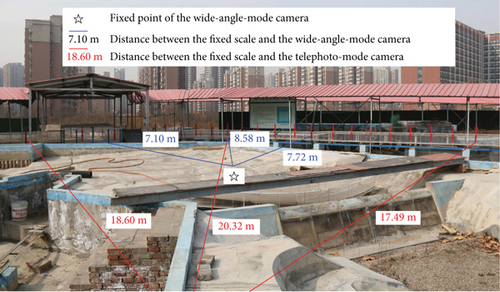
3.3. Calibration of the Bottom Elevation of the Fixed Scale
When the outlet gate of the Qinling Tunnel and the inlet gate of the Southern Main Tunnel of the model are fully opened, the water is in the flow condition. When the outlet gate of the Qinling Tunnel and the outlet of the Southern Main Tunnel of the model are closed, the Water Distribution Pool and Southern Main Tunnel model reaches a static water condition. The needle is used to read the static water surface relative elevation in the Water Distribution Pool and the static water level is denoted as H0. Take photos of the fixed scales in the static water condition, and measure the height of each fixed scale (HFixed scale) and the height from the water surface to the bottom of the fixed scale (hFixed scale) in the image, as shown in Figure 3.
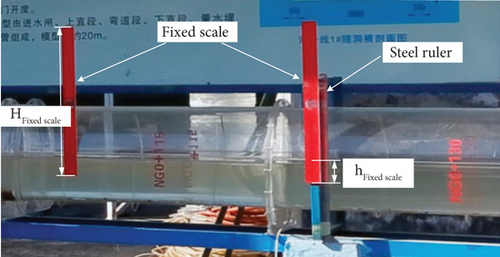
The relative elevation of the bottom of each fixed scale can be obtained by H0 − HWater.
The influence of opening and closing gate conditions on the water level of the open channel flow in the Southern Main Tunnel and the Water Distribution Pool can be seen in operating conditions 1 and 2 below.
It should be noted that the relative elevation of the water level and bottom edge of the fixed scale adopts the relative elevation of the prototype, and the other parameters adopt the model parameters in this paper. This makes it easy for the reader to understand the design characteristic parameter of the prototype.
4. Observation and Qualitative Analysis of Instantaneous Water Level in the Water Distribution Pool and the Southern Main Tunnel Model under Different Operating Conditions
4.1. Operating Condition 1
The flow in the Qinling Tunnel is 0.0246 m3/s, and the gate divergence of the Southern Main Tunnel inlet gate is 7.33 cm. The hub is in a steady-flow state. Figure 4(a) shows that the water level of the pool has reached 564.88 m at 2 s before closing the gate. The Southern Main Tunnel is in a steady-flow state behind the gate, and the water surface of the Water Distribution Pool is calm. We suddenly close the inlet gate of the Southern Main Tunnel with a speed of 0.329 m/s. At 2 s after closing the gate, the flow state is as shown in Figure 4(b). The water level in the tunnel drops suddenly between the gate and the no. 7 scale, and the hydraulic oscillation is obvious, while the water level of the downstream does not change and the water level of the Water Distribution Pool is calm. At 5 s after closing the gate, the flow state is shown in Figure 4(c). The water level in the tunnel has decreased to the no. 14 scale, and the water wave oscillates violently from the no. 10 scale to the no. 14 scale. At 85 s after closing the gate, the flow state is as shown in Figure 4(d). There is no water in the Southern Main Tunnel, and the water level of the pool continues to rise and the water surface is calm.




4.2. Operating Condition 2
The flow in the Qinling Tunnel is 0.0246 m3/s, and the inlet gate of the Southern Main Tunnel is fully closed, while the water level in the Water Distribution Pool rises to 565.88 m and the Southern Main Tunnel has no flow. Figure 5(a) shows that the water level in the Water Distribution Pool has reached 565.88 m at 2 s before opening the gate. The water level of the pool is calm. We suddenly open the inlet gate of the Southern Main Tunnel with a speed of 1.538 m/s. At 1 s after opening the gate, the flow state is as shown in Figure 5(b). The water level of the pool near the inlet gate of the Southern Main Tunnel decreases obviously, and the fluctuation of the water level is obvious. The front of the water wave reaches the no. 8 scale. Figure 5(c) is the panoramic view at 4 s after opening the gate. The water level of the Water Distribution Pool continues dropping, and the water surface fluctuation is larger. The water wave front of the Southern Main Tunnel has reached between the no. 14 and no. 8 scale, and the water surface fluctuates greatly. Figure 5(d) shows the panorama view at 300 s after opening the gate. The water level in the Water Distribution Pool drops significantly and is basically equivalent to that in the Southern Main Tunnel. The flow through the Southern Main Tunnel is the same as that through the Qinling Tunnel. The Huangchigou Water Distribution Hub reaches a steady-flow state.




5. Quantitative Analysis of Instantaneous Water Level in the Water Distribution Pool and the Southern Main Tunnel Model under Different Operating Conditions
5.1. Under Operating Condition 1
The instantaneous water level at each measuring point is shown in Figure 6. After suddenly closing the inlet gate of the Southern Main Tunnel, the water level behind the gate drops successively. The fluctuation of the water surface behind the gate is large, and the fluctuation of water surface is small away from the gate in the Southern Main Tunnel. The water level in the Water Distribution Pool rises slowly.
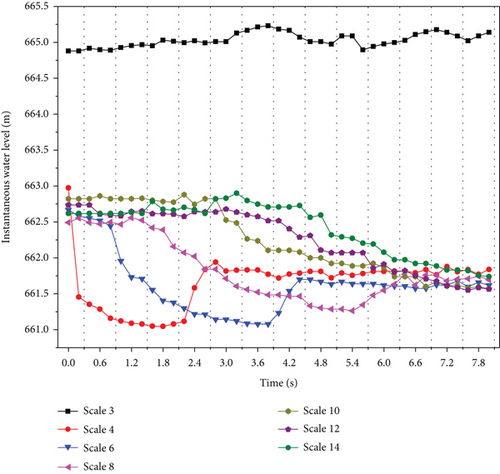
The instantaneous water surface profiles at different times are shown in Figure 7. It can be seen that when the inlet gate divergence is 7.33 cm, the water level of the Southern Main Tunnel is roughly at the same height. After rapid closing of the inlet gate, the water level of the pool rises rapidly at first and gradually rises slowly, and finally, water passes through the side tank. The wave front propagation velocity in the South Main Tunnel is 2.217 m/s. After closing the gate for 20 s, the water level in the Water Distribution Pool reaches 565 m, and backwater begins to enter the side tank backwater channel. After 85.0 s, the water in the Southern Main Tunnel disappeared.
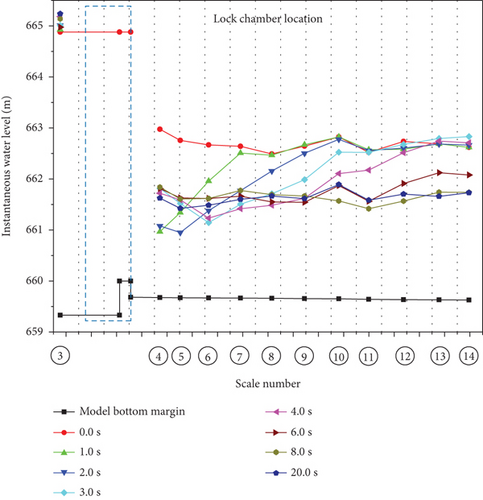
5.2. Under Operating Condition 2
The instantaneous water level of each measuring point is shown in Figure 8. After suddenly opening the inlet gate of the Southern Main Tunnel, the water level behind the inlet gate rises successively. The fluctuation of the water surface near the inlet gate in the Southern Main Tunnel is large, and the fluctuation of the water surface is small away from the inlet gate. The water level in the pool drops slowly.

The instantaneous water surface profiles at different times are shown in Figure 9. After rapid opening of the inlet gate, it can be seen that the water level of the pool drops continuously, and the water level of each measuring point in the Southern Main Tunnel rises successively from the upstream to the downstream. At 4.0 s after opening the gate, the water wave front reaches the no. 14 scale, and the water wave propagation velocity in the model is 2.494 m/s. At 11.8 s after opening the gate, the flow in the Southern Main Tunnel reaches a quasiconstant flow state. The water surface oscillation is obviously small, but the water level of the pool is still very high. The water level of the pool experienced a process of rapid decline, then a slow decline to becoming gradually stable. At 300.0 s after opening the gate, the water level of the pool was basically consistent with that in the Southern Main Tunnel, and the flow reached a steady-flow state.
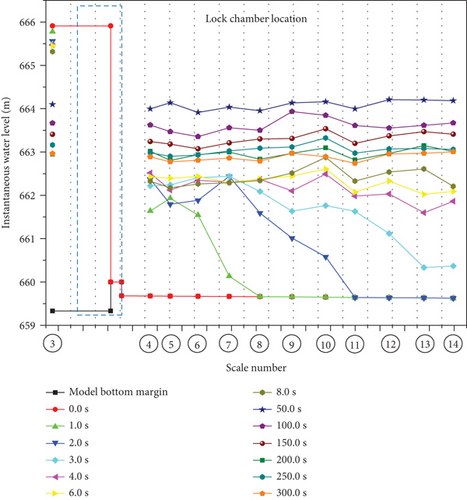
Table 1 is the statistical table of hydraulic characteristic parameters in the Huangchigou Water Distribution Hub. It can be seen that under the operating condition 1, the side tank of the hub starts to withdraw water at 20 s after the inlet gate of the Southern Main Tunnel closes. Under the operating condition 2, at 300 s after the inlet gate opening, the water in the Water Distribution Pool and the Southern Main Tunnel reaches a constant flow state, and the unsteady-flow transition has completed. The velocity of the rising wave is slightly greater than that of the falling wave. The results of the model test have an important reference value for the opening and closing rules of the gate in the Huangchigou Water Distribution Hub.
| Operating condition | Gate opening or closing speed (m/s) | Wave velocity (m/s) | Quasi-steady-flow duration (s) | Unsteady-flow duration (s) |
|---|---|---|---|---|
| 1 | Closing, 0.329 | 2.217 | After 10.0 s, most of the hydraulic oscillation phenomena in the Southern Main Tunnel disappeared | After 20.0 s, the side tank in the Water Distribution Pool starts to withdraw water. After 85.0 s, the water in the Southern Main Tunnel disappeared |
| 2 | Opening, 1.538 | 2.494 | After 11.8 s, most of the hydraulic oscillation phenomena in the Southern Main Tunnel disappeared | After 300.0 s, the Water Distribution Pool and the Southern Main Tunnel reached a steady-flow state |
6. Conclusion
- (1)
In this paper, an instantaneous water level-measuring method based on a single-camera and fixed-scale compensation method for unsteady flow was proposed. This method is suitable for hydraulic model experiments made of transparent materials.
- (2)
Compared with the prototype gate-opening and gate-closing speeds, the gate-closing speed in this paper corresponds to the sudden accident in general, that is, the gate suddenly falls. The gate-opening speed of the model is very high. Compared with ability of the gate opening speed of the prototype, this possibility does not exist, but it has a good effect to correct the numerical model of unsteady flow in the open channel.
- (3)
Under operating condition 1, when the water level in the Water Distribution Pool reaches 654.88 m, the inlet gate of the Southern Main Tunnel is closed suddenly. The velocity of the water wave in the Southern Main Tunnel is 2.217 m/s. After 20.0 s, the water level of the Water Distribution Pool rises to 665.00 m, and the side tank begins to withdraw water. After 85.0 s, the water in the Southern Main Tunnel disappeared.
- (4)
Under operating condition 2, when the water level of the Water Distribution Pool reaches 665.88 m, the inlet gate of the Southern Main Tunnel is opened suddenly. The velocity of water wave in the Southern Main Tunnel is 2.494 m/s. After 11.8 s, most of the hydraulic oscillation phenomena in the Southern Main Tunnel disappeared. After 300.0 s, the Water Distribution Pool and the Southern Main Tunnel reached a steady-flow state.
The precious data such as the velocity of the water wave and the recovery time of the hydraulic oscillation was obtained in this experiment. The research has an important reference value for the study and design of water transfer dispatching and gate-opening and gate-closing rules in the Huangchigou Water Distribution Hub.
Conflicts of Interest
The authors declare that they have no conflicts of interest.
Acknowledgments
This study is sponsored by the Natural Science Basic Research Project of Shaanxi Province (2019JLZ-16) and the National Natural Science Foundation of China (No. 52208289).
Open Research
Data Availability
The raw/processed data required to reproduce these findings cannot be shared at this time as the data also forms part of an ongoing study.




